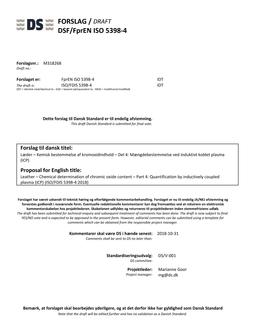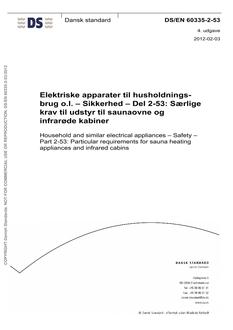-
-
Available Formats
- Availability
- Priced From ( in USD )
-
Available Formats
-
- Immediate download
- $64.00
- Add to Cart
-
- Printed Edition
- Ships in 1-2 business days
- $64.00
- Add to Cart
Customers Who Bought This Also Bought
-

DANSK DS/EN 2266-008
Priced From $44.00 -

DANSK DS/EN IEC 61169-1-6
Priced From $60.00 -

DANSK DSF/FPREN ISO 5398-4
Priced From $29.00 -

DANSK DS/EN 60335-2-53
Priced From $78.00
About This Item
Full Description
This International Standard specifies four different methods, designated A to D, for the examination of colour. The previously most employed method for assessment of water colour in water treatment plants, limnological surveys etc. was based on the hexachloroplatinate scale (Reference [1]). Methods C and D are harmonized with this traditional procedure (References [2][3]). Method A involves examination of apparent colour by visually observing a water sample in a bottle. This gives only preliminary information, for example for use in field work. Only the apparent colour can be reported. Method B involves determination of the true colour of a water sample using optical apparatus and is applicable to raw and potable water and to industrial water of low colour. A subclause on interferences is included. Method C involves determination of the true colour of a water sample using optical apparatus for comparison with hexachloroplatinate concentration at wavelength, ? ? 410 nm. A subclause on interferences is included. Method D involves determination of colour by visual comparison with hexachloroplatinate standard solutions and can be applied to raw and drinking water. A subclause on interferences is included. Methods C and D are appropriate if the colour hue of the sample differs from the hue of the matching solution. NOTE 1 Under certain circumstances, strongly coloured water samples require dilution before examination or determination. However, this can alter the physical-chemical conditions leading to a change in colour. NOTE 2 An internal quality control procedure for all methods specified in this International Standard is given in Annex A. When stating the result, the procedure used (methods A to D) is also recorded. Under certain circumstances, strongly coloured water samples need to be diluted before examination or determination. However, this may alter the physical-chemical conditions leading to a change in colour. One purpose of the present revision is to forward the use of colour units (CU) instead of the traditional unit mg Pt l-1 which is often a cause of confusion, since the element Pt is hardly present in the sample. When stating the result, it is absolutely necessary to refer to the applied procedure (Clauses 4 to 7).





